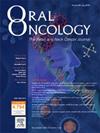Treatment outcomes of sinonasal adenoid cystic carcinoma: a single-center experience
IF 4
2区 医学
Q1 DENTISTRY, ORAL SURGERY & MEDICINE
引用次数: 0
Abstract
Objective
Sinonasal adenoid cystic carcinoma (ACC) is a rare malignancy characterized by perineural invasion and a high risk of late recurrence. This study examines the clinical characteristics and treatment outcomes of patients with sinonasal ACC treated at a single institution over 15 years.
Patients and methods
A retrospective analysis was conducted on 19 patients with histologically confirmed sinonasal ACC treated at Chonnam National University Hwasun Hospital from 2010 to 2024.
Results
Nasal obstruction was the most common presenting symptom (57.8 %), followed by facial pain and numbness (21.0 %) and epistaxis (10.5 %). The maxillary sinus was the most frequently affected site (52.6 %). At initial diagnosis, regional lymph node and distant metastases were each observed in one patient. Most cases were diagnosed at stage IV (57.9 %), with perineural invasion detected in 31.6 % of cases. Among the 17 patients who completed treatment, surgery followed by radiotherapy was the predominant treatment modality (82.4 %). Two patients were deemed inoperable and received definitive chemoradiotherapy or best supportive care. Over a mean follow-up of 87.5 ± 60.2 months, 11 patients (64.7 %) experienced recurrence, with a mean time to recurrence of 52.8 ± 45.7 months. Survival analysis identified tumor stage as the only significant prognostic factor (p < 0.05).
Conclusion
Sinonasal ACC is frequently diagnosed at an advanced stage and demonstrates a high recurrence rate despite multimodal treatment. The tumor stage emerged as the strongest prognostic indicator of survival, highlighting the need for early detection and aggressive therapeutic interventions to improve patient outcomes.
鼻窦腺样囊性癌的治疗结果:单中心经验
目的鼻腺样囊性癌(ACC)是一种罕见的恶性肿瘤,其特点是侵犯神经周围,晚期复发风险高。本研究探讨了在单一机构治疗超过15年的鼻窦型ACC患者的临床特征和治疗结果。患者与方法回顾性分析2010 ~ 2024年全南大学华顺医院收治的19例经组织学证实的鼻窦型ACC患者。结果鼻塞是最常见的症状(57.8%),其次是面部疼痛和麻木(21.0%)和鼻出血(10.5%)。上颌窦是最常见的受累部位(52.6%)。在最初的诊断中,每个患者都观察到区域淋巴结和远处转移。大多数病例诊断为IV期(57.9%),31.6%的病例发现神经周围侵犯。在完成治疗的17例患者中,手术后放疗是主要的治疗方式(82.4%)。2例患者被认为不能手术,接受了明确的放化疗或最佳支持治疗。平均随访87.5±60.2个月,11例(64.7%)复发,平均复发时间为52.8±45.7个月。生存分析发现肿瘤分期是唯一重要的预后因素(p <;0.05)。结论鼻窦型ACC多诊断于晚期,虽经多种治疗,复发率高。肿瘤分期成为最重要的生存预后指标,强调了早期发现和积极治疗干预以改善患者预后的必要性。
本文章由计算机程序翻译,如有差异,请以英文原文为准。
求助全文
约1分钟内获得全文
求助全文
来源期刊

Oral oncology
医学-牙科与口腔外科
CiteScore
8.70
自引率
10.40%
发文量
505
审稿时长
20 days
期刊介绍:
Oral Oncology is an international interdisciplinary journal which publishes high quality original research, clinical trials and review articles, editorials, and commentaries relating to the etiopathogenesis, epidemiology, prevention, clinical features, diagnosis, treatment and management of patients with neoplasms in the head and neck.
Oral Oncology is of interest to head and neck surgeons, radiation and medical oncologists, maxillo-facial surgeons, oto-rhino-laryngologists, plastic surgeons, pathologists, scientists, oral medical specialists, special care dentists, dental care professionals, general dental practitioners, public health physicians, palliative care physicians, nurses, radiologists, radiographers, dieticians, occupational therapists, speech and language therapists, nutritionists, clinical and health psychologists and counselors, professionals in end of life care, as well as others interested in these fields.
 求助内容:
求助内容: 应助结果提醒方式:
应助结果提醒方式:


